
Cancer is a genus of marine crabs in the family Cancridae. It includes eight extant species and three extinct species, including familiar crabs of the littoral zone, such as the European edible crab, the Jonah crab and the red rock crab. It is thought to have evolved from related genera in the Pacific Ocean in the Miocene.

The Ocypodidae are a family of semiterrestrial crabs that includes the ghost crabs and fiddler crabs. They are found on tropical and temperate shorelines around the world.
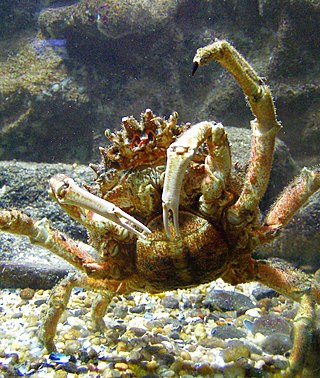
Maja is a genus of majid crabs erected by Jean-Baptiste Lamarck in 1801. It includes the following extant species:

Cancridae is a family of crabs. It comprises six extant genera, and ten exclusively fossil genera, in two subfamilies:

Xanthoidea is a superfamily of crabs, comprising seven families. Formerly, a number of other families were included in Xanthoidea, but many of these have since been removed to other superfamilies. These include Carpilioidea, Eriphioidea, Hexapodoidea, Pilumnoidea and Trapezioidea. Even in this reduced state, Xanthoidea remains one of the most species-rich superfamilies of crabs.
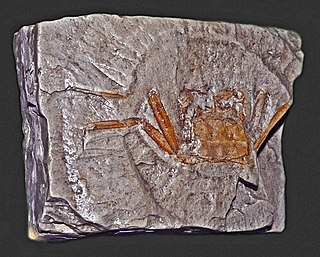
Retroplumidae is a family of heterotrematan crabs, placed in their own (monotypic) superfamily, Retroplumoidea.

The thumbnail crab, Thia scutellata, is a species of decapods, in the family of thiidae, whose carapace resembles a human thumbnail, a dense fringe of long hairs distinctly notched around the edge. Pale pink in colour with red to brown markings. It is found in the North Sea, north-east Atlantic and Mediterranean Sea. It is the only extant species in the genus Thia, although two fossil species are known. Their predators includes the atlantic cod.
Gecarcinucoidea is a superfamily of freshwater crabs. Its members have been grouped into families in various ways, with some authors recognizing families such as "Deckeniidae", "Sundathelphusidae", and "Parathelphusidae", but now only the family Gecarcinucidae is currently recognized.

Albuneidae is a little-known family of specialized burrowing sand crabs. There are 50 extant species as well as nine fossil species that have been described. Fossil specimens have been described from the Cretaceous, Miocene and Oligocene.

Metacarcinus is a genus of crabs formerly included in the genus Cancer. It includes nine exclusively fossil species and five extant species, of which four are also known from the fossil record. A molecular study using the cytochrome oxidase I gene does not support the monophyly of this genus.

Cheiragonidae is a small family of crabs, sometimes called helmet crabs, placed in its own superfamily, Cheriagonoidea. It comprises three extant species, Erimacrus isenbeckii, Telmessus acutidens and Telmessus cheiragonus, there are no yet evidences of Cheiragonidae in the fossil record. Many of these crabs were formerly treated as members of the Atelecyclidae.

Matutidae is a family of crabs, sometimes called moon crabs, adapted for swimming or digging. They differ from the swimming crabs of the family Portunidae in that all five pairs of legs are flattened, rather than just the last pair, as in Portunidae. Crabs in the Matutidae are aggressive predators.
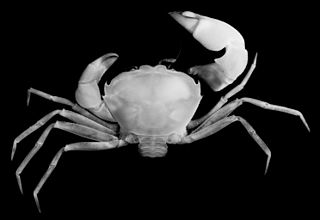
Pseudozioidea is a superfamily of crabs, formerly treated in the Eriphioidea, Carpilioidea, Xanthoidea, Pilumnoidea and Goneplacoidea. A number of fossils from the Eocene onwards are known from the family Pseudoziidae. Eleven genera are recognised in three families:
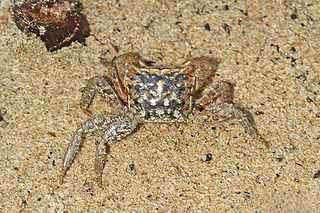
Metopograpsus is a genus of crabs, containing the following extant species:

Epialtidae is a family of crabs, containing the subfamilies:

Panopeus is a genus of crabs, containing these extant species:

Hepatus is a genus of crabs in the family Aethridae, containing seven extant species, plus some fossil species:

Zosimus is a genus of crabs in the family Xanthidae, containing the following species:

Mathildellidae is family of crabs belonging to the superfamily Goneplacoidea, containing the following genera:
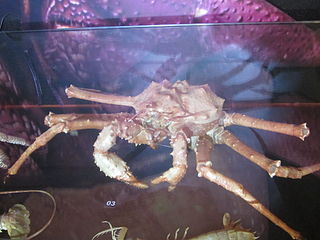
Lithodes turritus is a species of king crab. It is found in Japan, the East China Sea, Taiwan, and the Philippines at depths from 300–812 metres (984–2,664 ft).



















